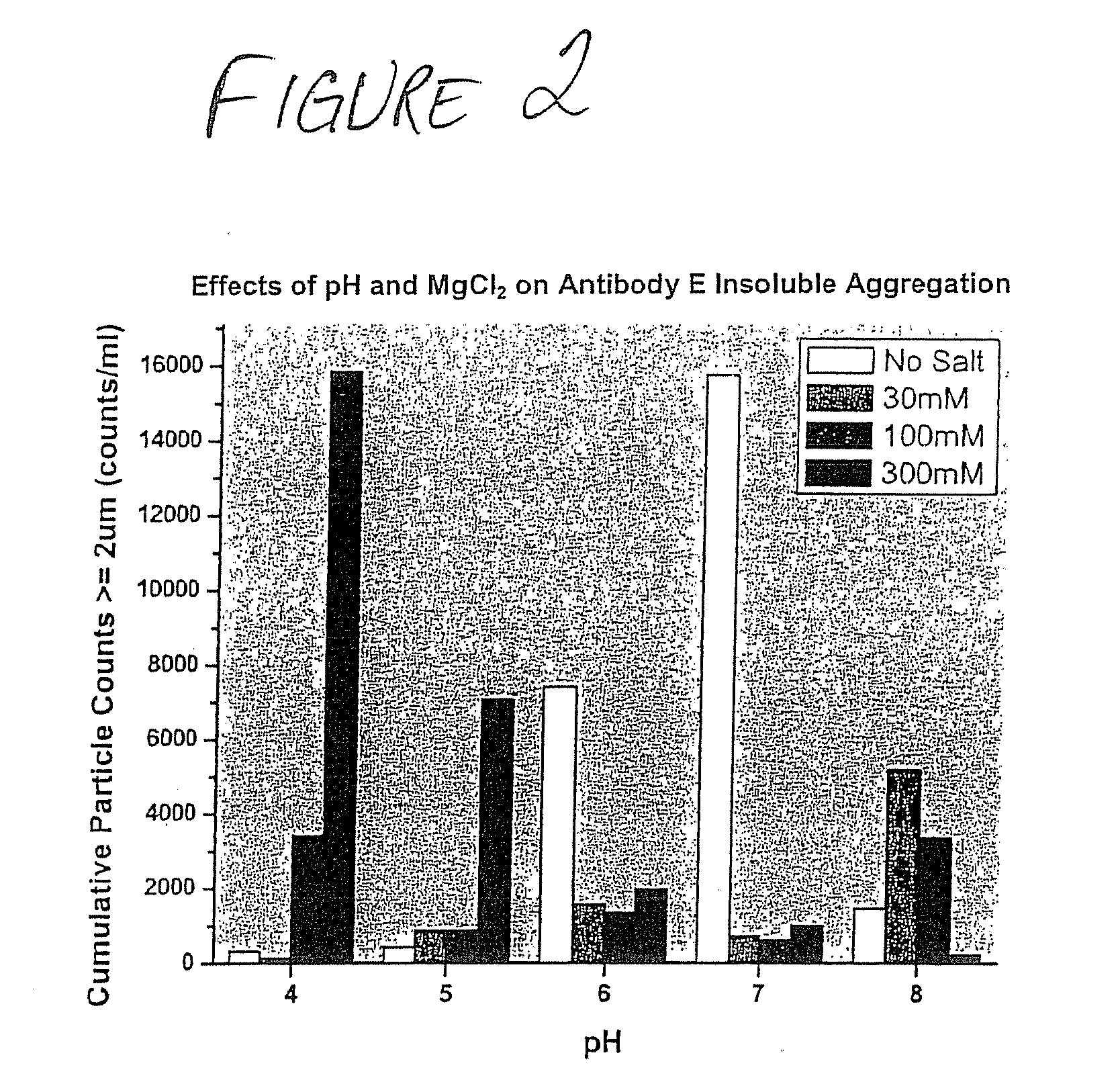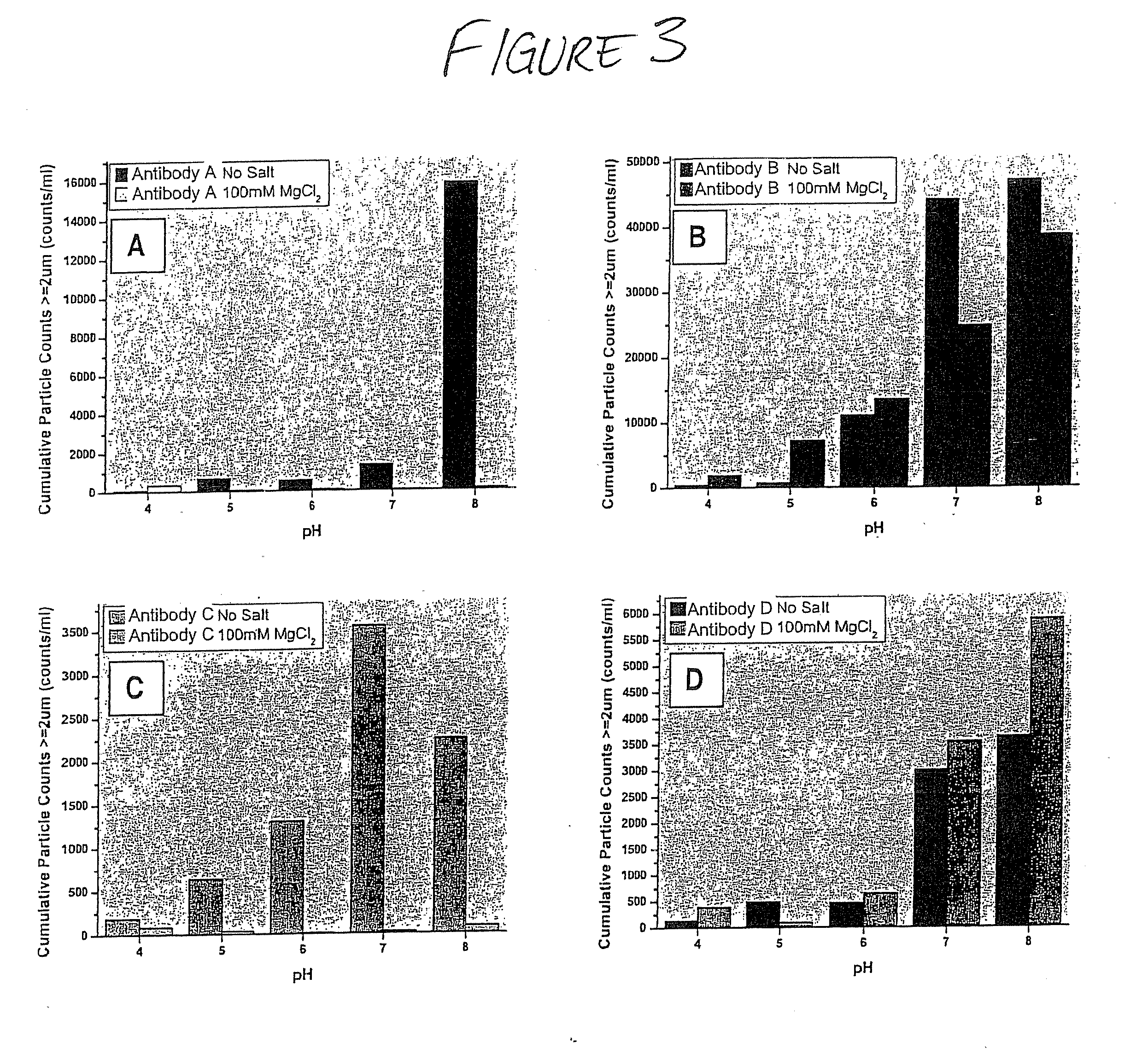Formulations that inhibit protein aggregation
a technology of protein aggregation and formulation, applied in the field of pharmaceutical formulations containing proteins, can solve the problems of protein fragments that are protein fragments that are unstable and susceptible to loss of activity and/or formation, etc., to achieve the effect of inhibiting the formation of protein aggrega
- Summary
- Abstract
- Description
- Claims
- Application Information
AI Technical Summary
Problems solved by technology
Method used
Image
Examples
example 1
Formulation Preparation
[0042] A series of formulations was prepared for each of the tested agents that inhibit freeze / thaw-inducted aggregate formation. Each formulation was prepared similarly. Test samples (2 mL) were prepared in 5 mL vials equipped with Daikyo stoppers. Concentrated buffer stock (20 mM K / OAc, 20 mM K / PO4 at each tested pH value) was added to each sample to a final concentration of 5 mM K / OAc, 5 mM K / PO4, at each pH value tested. Individual protein stock solutions (˜30 mg / mL) were added to each formulation to a final protein concentration of ˜10 mg / mL. Additional stock solutions of the agents that inhibit aggregate formation that were prepared include 5.0 M MgCl2; 5% Pluronic-F68; 100% (v / v) EtOH; and 100% (v / v) propylene glycol. These stock solutions were added to the formulations to final concentration ranges noted in the disclosure below, typically 30-300 mM (MgCl2); 0.01-1.0% (Pluronic-F68); 0.2-10% (EtOH); and 1-10% (propylene glycol). If necessary, deionize...
example 2
[0055] Inhibition of Protein Aggregate Formation During Agitation Stress
[0056] Each formulation is prepared using the antibodies as described in Example 1, with buffer conditions including: (a) 5 mM sodium acetate, 5 mM potassium phosphate, pH 7 (control sample); (b) 5 mM sodium acetate, 5 mM potassium phosphate, 100 mM MgCl2, pH 7; (c) 5 mM sodium acetate, 5 mM potassium phosphate, 0.1% Pluronic F68, pH 7; and (d) 5 mM sodium acetate, 5 mM potassium phosphate, 10% propylene glycol, pH 7. These formulations are prepared using any method known to those skilled in the art, such as dialysis, diafiltration, buffer exchange (chromatography, centrifuge filtration, etc.). Those of skill in the art are able to identify the proper materials needed for such preparation (molecular weight cut-off of dialysis tubing and diafiltration membranes, etc.). Once a typical protein concentration is achieved (e.g., ˜10 mg / mL), the sample vials are sealed with stoppers and placed in a 5 cc×16 box with th...
PUM
| Property | Measurement | Unit |
|---|---|---|
| temperatures | aaaaa | aaaaa |
| pH | aaaaa | aaaaa |
| pH | aaaaa | aaaaa |
Abstract
Description
Claims
Application Information
 Login to View More
Login to View More - R&D
- Intellectual Property
- Life Sciences
- Materials
- Tech Scout
- Unparalleled Data Quality
- Higher Quality Content
- 60% Fewer Hallucinations
Browse by: Latest US Patents, China's latest patents, Technical Efficacy Thesaurus, Application Domain, Technology Topic, Popular Technical Reports.
© 2025 PatSnap. All rights reserved.Legal|Privacy policy|Modern Slavery Act Transparency Statement|Sitemap|About US| Contact US: help@patsnap.com



